2018 HYUNDAI ELANTRA SPORT maintenance schedule
[x] Cancel search: maintenance schedulePage 444 of 534

Air Cleaner Filter
A genuine HYUNDAI air cleaner filter is recommended when the filter isreplaced.
Spark Plugs
Make sure to install new spark plugs
of the correct heat range.
Cooling System
Check cooling system components,
such as radiator, coolant reservoir,
hoses and connections for leakage
and damage. Replace any damaged
parts.
Engine Coolant
The coolant should be changed at
the intervals specified in the mainte-
nance schedule.
Automatic Transmission Fluid (if equipped)
Automatic transmission fluid should
not be checked under normal usage
conditions. But in severe conditions,the fluid should be changed at an
authorized HYUNDAI dealer inaccordance to the scheduled mainte-nance at the beginning of this chap-
ter.
Automatic transmission fluid
color is basically red.
As the vehicle is driven, the auto- matic transmission fluid will begin
to look darker. This is a normal
condition and you should not
judge the need to replace the fluid
based upon the changed color.
NOTICE
7-19
7
Maintenance
The use of a non-specified fluid could result in transmission
malfunction and failure. Use
only the specified automatic
transmission fluid (refer to"Recommended Lubricants and
Capacities" in chapter 8).
CAUTION
Page 445 of 534
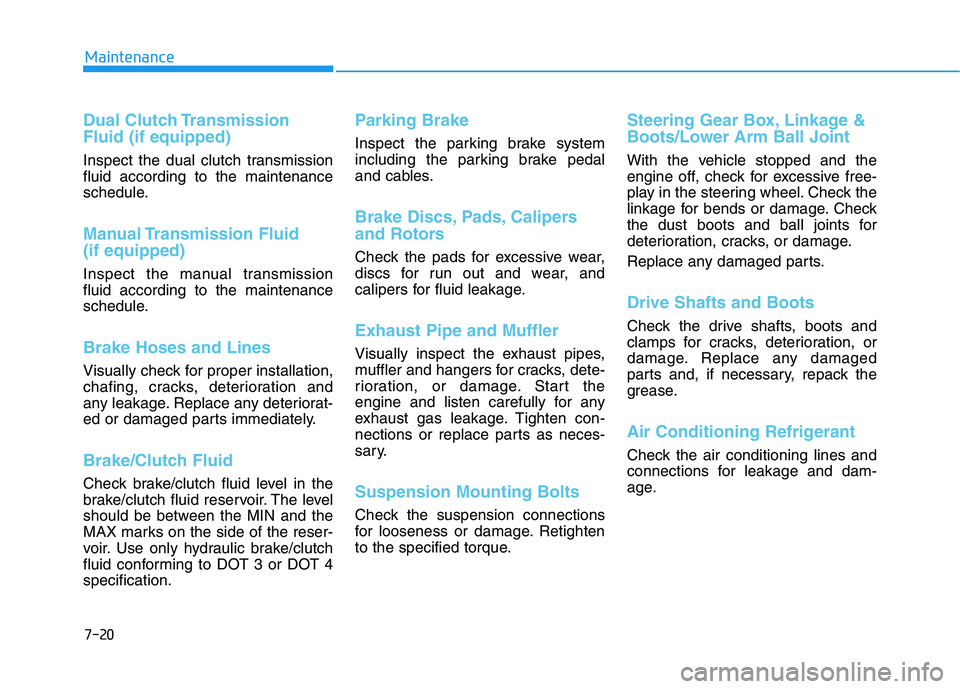
7-20
Maintenance
Dual Clutch Transmission Fluid (if equipped)
Inspect the dual clutch transmission fluid according to the maintenance
schedule.
Manual Transmission Fluid (if equipped)
Inspect the manual transmission fluid according to the maintenance
schedule.
Brake Hoses and Lines
Visually check for proper installation,
chafing, cracks, deterioration and
any leakage. Replace any deteriorat-
ed or damaged parts immediately.
Brake/Clutch Fluid
Check brake/clutch fluid level in the
brake/clutch fluid reservoir. The level
should be between the MIN and the
MAX marks on the side of the reser-
voir. Use only hydraulic brake/clutch
fluid conforming to DOT 3 or DOT 4specification.
Parking Brake
Inspect the parking brake system
including the parking brake pedal
and cables.
Brake Discs, Pads, Calipers
and Rotors
Check the pads for excessive wear,
discs for run out and wear, and
calipers for fluid leakage.
Exhaust Pipe and Muffler
Visually inspect the exhaust pipes,
muffler and hangers for cracks, dete-
rioration, or damage. Start the
engine and listen carefully for any
exhaust gas leakage. Tighten con-
nections or replace parts as neces-
sary.
Suspension Mounting Bolts
Check the suspension connections
for looseness or damage. Retighten
to the specified torque.
Steering Gear Box, Linkage &
Boots/Lower Arm Ball Joint
With the vehicle stopped and the
engine off, check for excessive free-
play in the steering wheel. Check the
linkage for bends or damage. Check
the dust boots and ball joints for
deterioration, cracks, or damage.
Replace any damaged parts.
Drive Shafts and Boots
Check the drive shafts, boots and
clamps for cracks, deterioration, or
damage. Replace any damaged
parts and, if necessary, repack the
grease.
Air Conditioning Refrigerant
Check the air conditioning lines and
connections for leakage and dam-
age.
Page 447 of 534
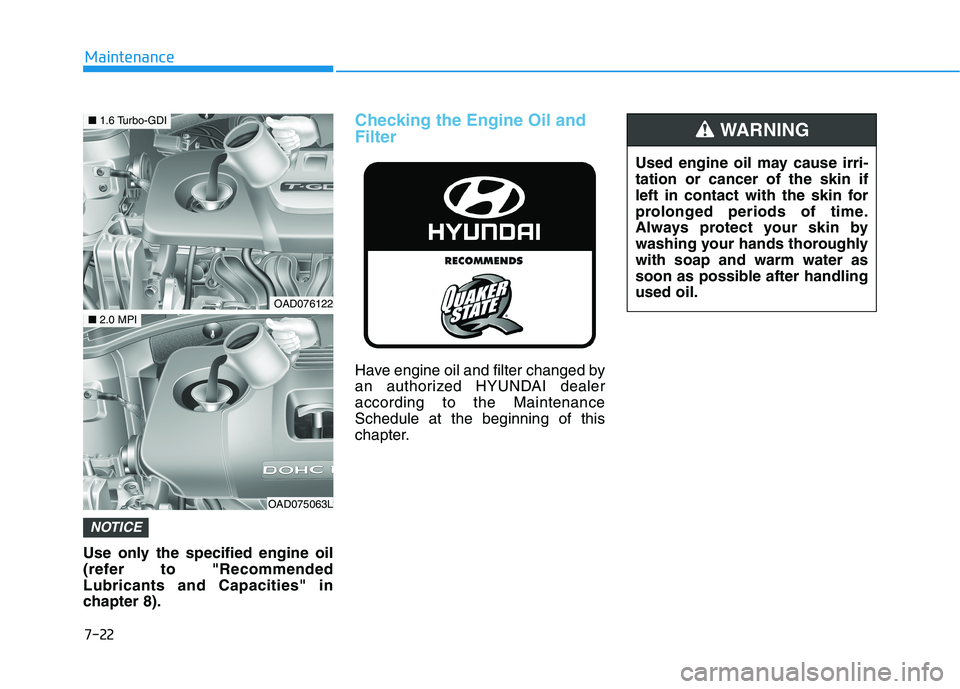
7-22
Maintenance
Use only the specified engine oil
(refer to "RecommendedLubricants and Capacities" in
chapter 8).
Checking the Engine Oil and Filter
Have engine oil and filter changed by
an authorized HYUNDAI dealeraccording to the MaintenanceSchedule at the beginning of this
chapter.
NOTICE
Used engine oil may cause irri- tation or cancer of the skin if
left in contact with the skin for
prolonged periods of time.
Always protect your skin by
washing your hands thoroughlywith soap and warm water as
soon as possible after handlingused oil.
WARNING
OAD076122
■1.6 Turbo-GDI
OAD075063L
■2.0 MPI
Page 451 of 534
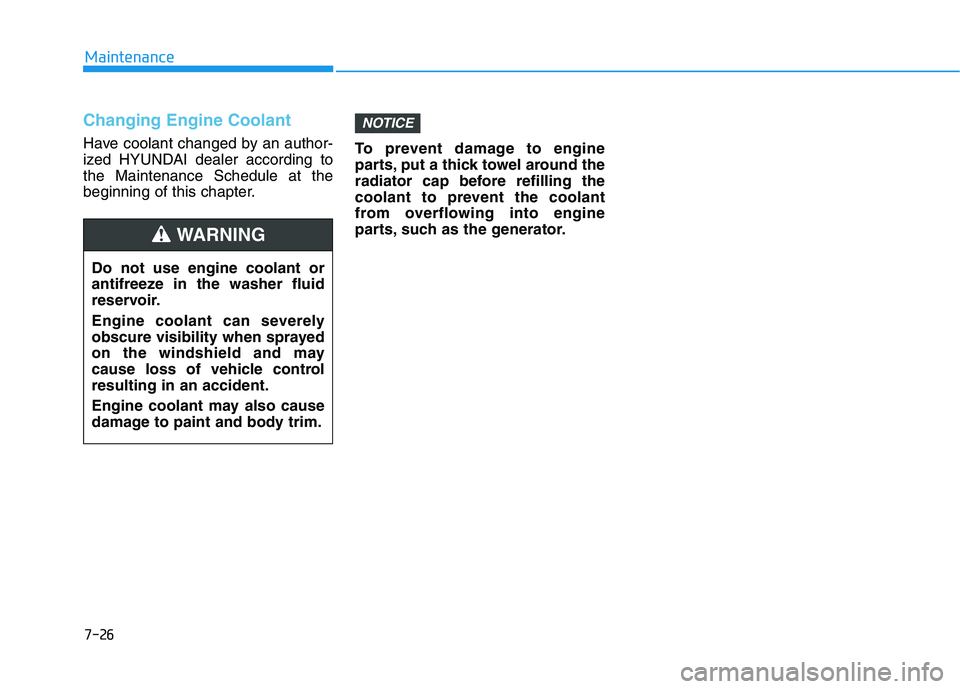
Changing Engine Coolant
Have coolant changed by an author-
ized HYUNDAI dealer according tothe Maintenance Schedule at the
beginning of this chapter.To prevent damage to engine
parts, put a thick towel around the
radiator cap before refilling the
coolant to prevent the coolant
from overflowing into engine
parts, such as the generator.
NOTICE
7-26
Maintenance
Do not use engine coolant or
antifreeze in the washer fluid
reservoir.
Engine coolant can severely
obscure visibility when sprayed
on the windshield and may
cause loss of vehicle controlresulting in an accident.
Engine coolant may also cause
damage to paint and body trim.
WARNING
Page 456 of 534
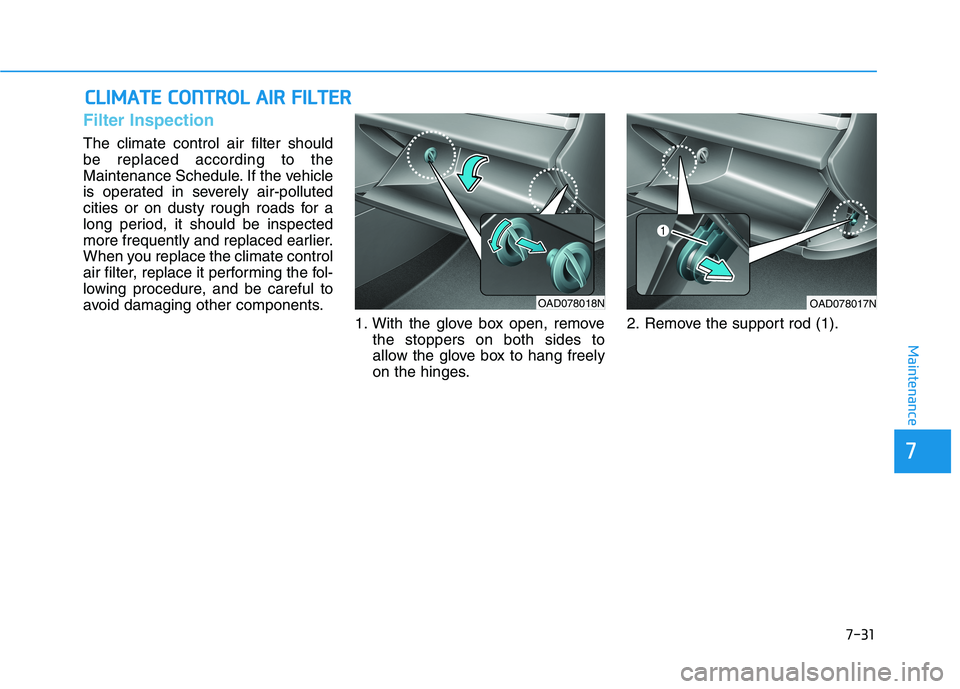
7-31
7
Maintenance
CCLLIIMM AATTEE CC OO NNTTRR OO LL AA IIRR FF IILL TT EERR
Filter Inspection
The climate control air filter should be replaced according to the
Maintenance Schedule. If the vehicle
is operated in severely air-polluted
cities or on dusty rough roads for a
long period, it should be inspected
more frequently and replaced earlier.
When you replace the climate control
air filter, replace it performing the fol-
lowing procedure, and be careful to
avoid damaging other components.
1. With the glove box open, removethe stoppers on both sides to
allow the glove box to hang freely
on the hinges. 2. Remove the support rod (1).
OAD078017NOAD078018N
Page 509 of 534

7-84
Maintenance
The emission control system of your
vehicle is covered by a written limited
warranty. Please see the warranty
information contained in the Service
Passport in your vehicle.
Your vehicle is equipped with an emission control system to meet all
applicable emission regulations.There are three emission control
systems, as follows.
(1) Crankcase emission control sys-tem
(2) Evaporative emission control sys- tem
(3) Exhaust emission control systemIn order to assure the proper function
of the emission control systems, it is
recommended that you have your
vehicle inspected and maintained by
an authorized HYUNDAI dealer inaccordance with the maintenance
schedule in this manual. For the Inspection and
Maintenance Test (With Electronic
Stability Control (ESC) system)
To prevent the vehicle from mis-
firing during dynamometer test-
ing, turn the Electronic Stability
Control (ESC) system off by
pressing the ESC switch (ESCOFF light illuminated).
After dynamometer testing is completed, turn the ESC system
back on by pressing the ESC
switch again.1. Crankcase Emission Control
System
The positive crankcase ventilation
system is employed to prevent air
pollution caused by blow-by gases
being emitted from the crankcase.This system supplies fresh filtered air
to the crankcase through the air
intake hose. Inside the crankcase,
the fresh air mixes with blow-by
gases, which then pass through the
PCV valve into the induction system.
2. Evaporative Emission ControlSystem Including Onboard
Refueling Vapor Recovery
(ORVR)
The Evaporative Emission Control
System is designed to prevent fuel
vapors from escaping into the atmos-
phere. The ORVR system is
designed to allow the vapors fromthe fuel tank to be loaded into a can-ister while refueling at the gas sta-
tion, preventing the escape of fuel
vapors into the atmosphere.
NOTICE
EEMM IISS SSIIOO NN CC OO NNTTRR OO LL SS YY SSTT EEMM
Page 527 of 534
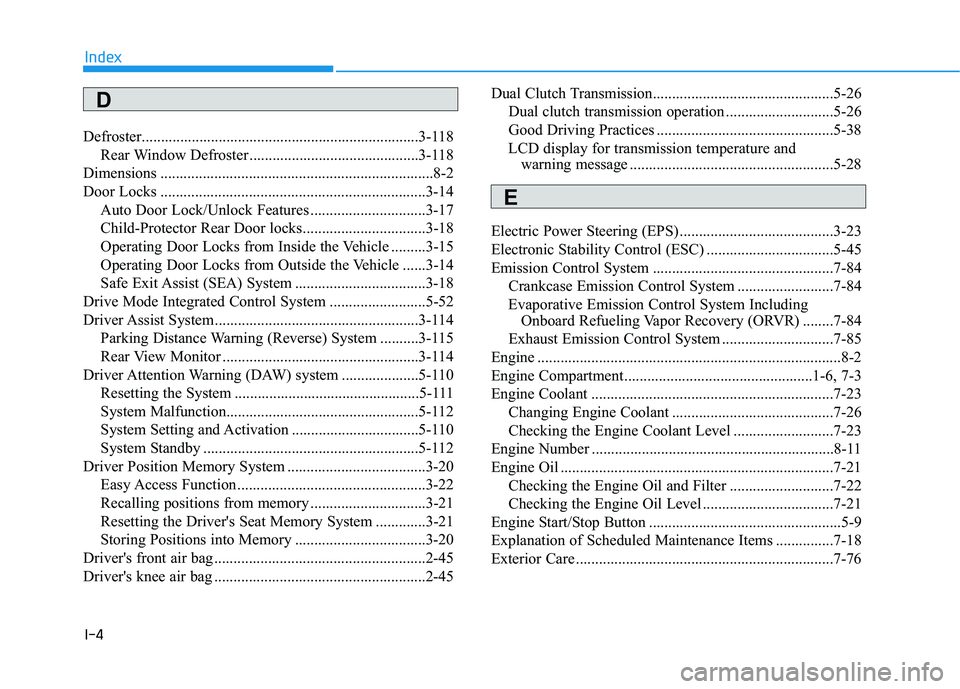
I-4
Defroster........................................................................3-118
Rear Window Defroster ............................................3-118
Dimensions .......................................................................8-2
Door Locks .....................................................................3-14 Auto Door Lock/Unlock Features ..............................3-17
Child-Protector Rear Door locks................................3-18
Operating Door Locks from Inside the Vehicle .........3-15
Operating Door Locks from Outside the Vehicle ......3-14
Safe Exit Assist (SEA) System ..................................3-18
Drive Mode Integrated Control System .........................5-52
Driver Assist System .....................................................3-114 Parking Distance Warning (Reverse) System ..........3-115
Rear View Monitor ...................................................3-114
Driver Attention Warning (DAW) system ....................5-110
Resetting the System ................................................5-111
System Malfunction..................................................5-112
System Setting and Activation .................................5-110
System Standby ........................................................5-112
Driver Position Memory System ....................................3-20 Easy Access Function .................................................3-22
Recalling positions from memory ..............................3-21
Resetting the Driver's Seat Memory System .............3-21
Storing Positions into Memory ..................................3-20
Driver's front air bag .......................................................2-45
Driver's knee air bag .......................................................2-45 Dual Clutch Transmission...............................................5-26
Dual clutch transmission operation ............................5-26
Good Driving Practices ..............................................5-38
LCD display for transmission temperature and warning message .....................................................5-28
Electric Power Steering (EPS) ........................................3-23
Electronic Stability Control (ESC) .................................5-45
Emission Control System ...............................................7-84 Crankcase Emission Control System .........................7-84
Evaporative Emission Control System Including Onboard Refueling Vapor Recovery (ORVR) ........7-84
Exhaust Emission Control System .............................7-85
Engine ...............................................................................8-2
Engine Compartment.................................................1-6, 7-3
Engine Coolant ...............................................................7-23 Changing Engine Coolant ..........................................7-26
Checking the Engine Coolant Level ..........................7-23
Engine Number ...............................................................8-11
Engine Oil .......................................................................7-21 Checking the Engine Oil and Filter ...........................7-22
Checking the Engine Oil Level ..................................7-21
Engine Start/Stop Button ..................................................5-9
Explanation of Scheduled Maintenance Items ...............7-18
Exterior Care ...................................................................7-76
Index
D
E
Page 531 of 534
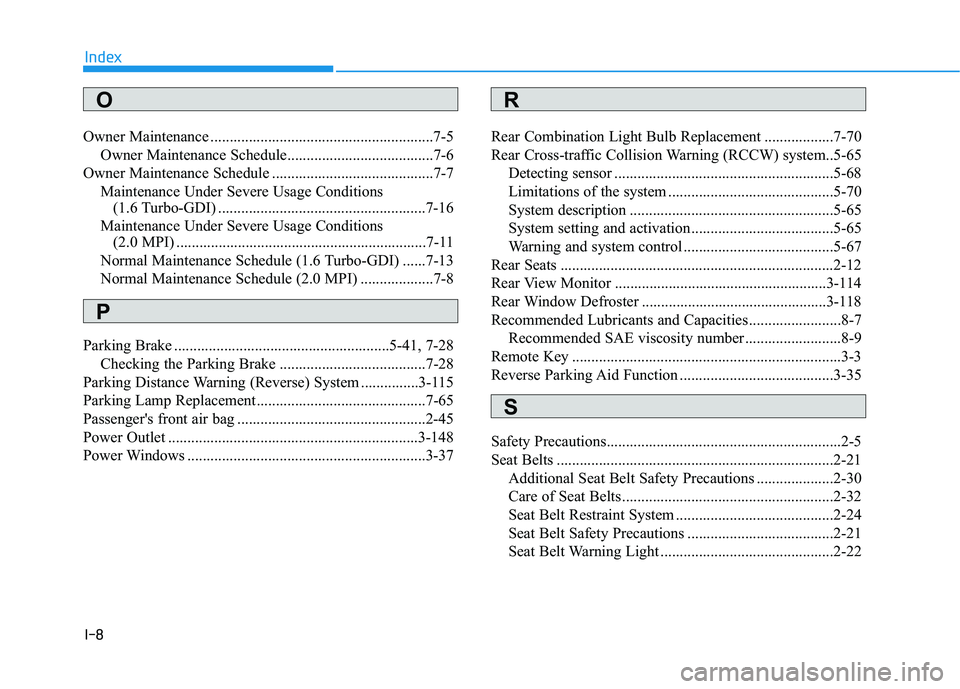
I-8
Owner Maintenance ..........................................................7-5
Owner Maintenance Schedule......................................7-6
Owner Maintenance Schedule ..........................................7-7 Maintenance Under Severe Usage Conditions (1.6 Turbo-GDI) ......................................................7-16
Maintenance Under Severe Usage Conditions (2.0 MPI) .................................................................7-11
Normal Maintenance Schedule (1.6 Turbo-GDI) ......7-13
Normal Maintenance Schedule (2.0 MPI) ...................7-8
Parking Brake ........................................................5-41, 7-28 Checking the Parking Brake ......................................7-28
Parking Distance Warning (Reverse) System ...............3-115
Parking Lamp Replacement............................................7-65
Passenger's front air bag .................................................2-45
Power Outlet .................................................................3-148
Power Windows ..............................................................3-37 Rear Combination Light Bulb Replacement ..................7-70
Rear Cross-traffic Collision Warning (RCCW) system..5-65
Detecting sensor .........................................................5-68
Limitations of the system ...........................................5-70
System description .....................................................5-65
System setting and activation .....................................5-65
Warning and system control .......................................5-67
Rear Seats .......................................................................2-12
Rear View Monitor .......................................................3-114
Rear Window Defroster ................................................3-118
Recommended Lubricants and Capacities ........................8-7 Recommended SAE viscosity number .........................8-9
Remote Key ......................................................................3-3
Reverse Parking Aid Function ........................................3-35
Safety Precautions.............................................................2-5
Seat Belts ........................................................................2-21 Additional Seat Belt Safety Precautions ....................2-30
Care of Seat Belts .......................................................2-32
Seat Belt Restraint System .........................................2-24
Seat Belt Safety Precautions ......................................2-21
Seat Belt Warning Light .............................................2-22
Index
S
O
P
R